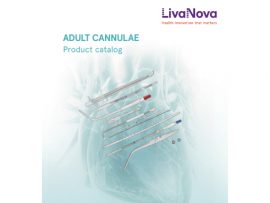Abstract Objective Patients on venoarterial extracorporeal membrane oxygenation undergoing ipsilateral cannulation may develop distal limb ischemia. We postulate 2 clinical questions: (1) Would contralateral cannulation have a lower distal limb..
Read MorePrevalence and Predictors of 3 Vital Outcomes After Venoarterial Extracorporeal Membrane Oxygenation
Abstract Background Predictors of death resulting from extracorporeal membrane oxygenation (ECMO) withdrawal, in-hospital death after ECMO liberation, and survival to hospital discharge have been evaluated incompletely, despite the prognostic insight..
Read MoreAbstract Background Evidence on prophylactic venoarterial extracorporeal membrane oxygenation (VA-ECMO) during elective percutaneous coronary intervention (PCI) in patients with complex high-risk coronary artery lesions is limited. Objectives The authors aimed..
Read MoreAbstract Background Venoarterial extracorporeal membrane oxygenation (VA-ECMO) is a life-saving mechanical support in patients with cardiogenic shock. There are great variations in the reported rates of neurological complications and associated..
Read MoreAbstract Background: The use of temporary mechanical circulatory support (tMCS) has revolutionized the management of cardiogenic shock (CS). However, standardized readiness-to-explant criteria for venoarterial extracorporeal membrane oxygenation (VA-ECMO) have not been..
Read MoreAbstract Introduction Current extracorporeal membrane oxygenation (ECMO) monitoring methods for circuit obstructions have limitations. In this study, we test the hypothesis that changes in flow in a pre-existing shunt tubing..
Read MoreAbstract BACKGROUND: Patients on venoarterial extracorporeal membrane oxygenation (VA-ECMO) are frequently managed with varying degrees of hyperoxia. Existing data suggest that higher levels of Pao2 correlate with worsened outcome in patients..
Read MoreAbstract Introduction Bleeding events are common during the provision of Venoarterial ECMO (VA ECMO). Previous observational has suggested that these bleeding events are associated with an increased risk of in-hospital..
Read MoreAbstract Objectives Extracorporeal Life Support (ECLS) has evolved into an established treatment for severe cardiogenic shock. As most patients have residual antegrade left ventricular output toward the descending aorta that..
Read MoreAbstract Introduction Two techniques are commonly used for the femoral artery puncture closure during decannulation in venoarterial extracorporeal membrane oxygenation (V-A ECMO): the conventional post-closure technique and the small-sheath technique, also..
Read MoreAbstract Background: The use of VA extracorporeal membrane oxygenation (ECMO) for cardiac recovery is widely adopted, with extensive publications on assessing readiness to wean from VA ECMO. Techniques to reduce..
Read MoreAbstract Introduction Femoral veno-arterial extracorporeal membrane oxygenation (VA-ECMO) is used as an ultima ratio to maintain circulation in patients with refractory cardiorespiratory failure, but is also associated with vascular and..
Read MoreAbstract Background Active mechanical circulatory support (MCS) is associated with high complication rates. Reducing device-related complications may improve outcomes in patients with infarct-related cardiogenic shock (AMI-CS). This study aims to..
Read MoreAbstract Extracorporeal Membrane Oxygenation (ECMO) is a life-saving cardiopulmonary support for patients with acute heart failure. However, the process of weaning from veno-arterial (V-A) ECMO remains complex and risky. We..
Read MoreAbstract Objectives To evaluate the effectiveness of levosimendan in promoting weaning from veno-arterial extracorporeal membrane oxygenation (VA-ECMO) in patients with refractory cardiogenic shock through a meta-analysis of clinical trials. Design Systematic review..
Read MoreAbstract Weaning from veno-arterial extracorporeal membrane oxygenation (V-A ECMO) and determining the optimal timing for liberation from mechanical circulatory support (MCS) remain critical yet complex. Although multiple weaning protocols exist,..
Read MoreAbstract Background The optimal transfusion threshold for patients undergoing venoarterial extracorporeal membrane oxygenation (VA-ECMO) remains uncertain. Methods We used data from OBLEX (ClinicalTrials.gov: NCT03714048), an international, prospective, observational study conducted..
Read MoreAbstract Extracorporeal cardiopulmonary resuscitation (ECPR) is an established intervention for select patients experiencing refractory cardiac arrest. Among modifiable predictors of survival and neurologic recovery during ECPR implementation, timely restoration of..
Read MoreAbstract Venoarterial extracorporeal membrane oxygenation (VA-ECMO) serves as a critical mechanical circulatory support modality, sustaining systemic circulation in cases of severe cardiac failure or cardiac arrest. While VA-ECMO improves hemodynamics,..
Read MoreAbstract Venoarterial extracorporeal membrane oxygenation (VA-ECMO) often leads to left ventricular (LV) overload, particularly in patients with biventricular cardiogenic shock. This increased afterload can hinder cardiac muscle recovery and cause..
Read MoreAbstract Background Congenital heart disease (CHD) that requires heart surgery is common. Severe postoperative pulmonary hypertension (PH) occurs in 2% of cardiac procedures and is associated with high morbidity and..
Read MoreAbstract Abstract Objectives: To investigate whether severe hyperoxia predisposes to end-organ complications and whether these complications contribute to in-hospital mortality among cardiogenic shock (CS) patients supported in veno-arterial extracorporeal membrane..
Read MoreVenoarterial extracorporeal membrane oxygenation (VA ECMO) provides temporary mechanical circulatory support for patients in refractory cardiogenic shock. Initiation of VA ECMO often results in increased left ventricular (LV) afterload as..
Read MoreAbstract Background Veno-arterial extracorporeal membrane oxygenation (VA-ECMO) use for cardiogenic shock (CS) is increasing worldwide despite conflicting results from randomized trials, which focused on myocardial-infarction related CS (MI-CS). Methods We..
Read MoreAbstract Post cardiac surgery shock (PCS) is a life-threatening condition that may require the use of mechanical circulatory support. Venoarterial (VA) extracorporeal membrane oxygenation (ECMO) is increasingly used to treat..
Read MoreAbstract Objectives To describe outcomes in patients who received venoarterial extracorporeal membrane oxygenation (VA-ECMO) for cardiogenic shock and to evaluate outcomes following programmatic changes. Design A retrospective cohort study. Setting..
Read MoreAbstract Background: Severe poisoning can lead to catastrophic cardiovascular collapse, often progressing to multiorgan failure and death. While intensive supportive care and pharmacological intervention remain the cornerstone of management, cases of..
Read MoreAbstract Background Limb ischemia is a serious complication of venoarterial (VA) extracorporeal membrane oxygenation (ECMO), potentially resulting in amputation, rhabdomyolysis, or death. This study aimed to evaluate the effectiveness of..
Read MoreAbstract Extracorporeal membrane oxygenation (ECMO) is widely recognized as a life-saving measure. The use of veno-arterial extracorporeal membrane oxygenation (VA ECMO) is on the rise, serving as an effective mechanical..
Read MoreAbstract Purpose To build a mock circulatory loop to simulate veno-arterial extracorporeal membrane oxygenation (V-A ECMO) haemodynamics using a patient-specific silicone aortic phantom and compare the flow dynamics for continuous..
Read More



















